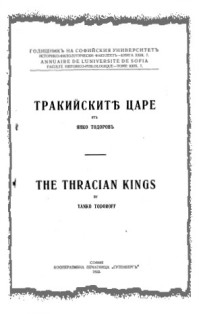
THRACIAN KINGS
Author: Yanko Todoroff

SUMMARY
In the preceding article is related the history of the Odrysian kings from the foundation of the Odrysian state in the first half of the fifth century B.C. to the end of the third century B.C., i.e. up to the destruction of the Celtic state of Tylis in the Balkan peninsula about 214 B.C. In general, the story of the following Odrysian Kings has been treated (Janko Todorov):
— Teres (470-440 B.C.), who was the founder of the Odrysian state;
— Sitalces (440-424 B.C.), during whose reign the Odrysian state reached its greatest territorial enlargement and its highest development;
— Seuthes I (424-410 B.C.), son of Sparadocus, the brother of Sitalces;
— Amadocos [Medocos] I (410-386 B.C.), in whose time Seuthes II, Maesades son, ruled in the region along the sea not only as a dependent ruler but also as an independent king. Thus for a certain time the Odrysian state was a dual monarchy;
— Hebryzelmis (386-384 B.C.), the successor of Medocos, who ruled the Odrysian state for a brief period and about whom we get our information only from coins and an Athenian decree;
— Cotys I (384-360 B.C.), he had a son, Kersebleptes, and two daughters: a married one to Iphicrit with son Menestei, and second daughter wedded to Timotei;
— Kersebleptes (360-341 B.C.), in whose reign the Odrysian kingdom fell under the rule of the Macedonians;
— Seutes III (330-313), thracian revolts during the time of Lysimachos have been mentioned and due consideration has been given to the opinion, according to which the Odrysian state did not completely vanish during the Macedonian rule;
— Cotys Raisco (a. 270/269 B.C.), from a Delphian inscription we learn about the thracian King who was honored by Delphi. This same Cotys and his son Raiscouporis are mentioned in a fragmentary inscription from Burgas.
— About 214 B.C., which year marks the end of the period considered in the preceding article the Odrysian state gained its complete liberty from the Celts. Celtic state at Tylis was completely destroyed.
An outstanding work on the history of the Odrysian state during the fifth and the fourth centuries before Christ remains the studies of A. Höck in "Hermes" XXVI (1891) pp. 76-117 and pp. 453-462, also "Hermes" XXXIII (1898) pp. 626-637. However, in the preceding article, the author has reached certain conclusions somewhat different from those of Höck.
Thus from a scholion on the 145th verse in the Acharnanians, the comedy of Aristophanes, Höck and some other authors draw the conclusion, that Sitalces had three sons, whose names were Teres, Sitalces, and Sadocos. The author of this article maintains the opinion that in the above mentioned scholion reference is made to only one son of Sitalces, whose name was Sadocos. Thucydides also speaks about Sadocos as a son of Sitalces.
Further the dual character of the Odrysian monarchy after the death of Seuthes I in the time of Amadocos and Seuthes II has been emphasized. The various suppositions made by Höck and other authors regarding the blood relations of the Odrysian kings have been pointed out; a great deal of these suppositions are not supported by historical evidence. On the contrary, the author supports Höck's opinion that the Delphian inscription in which the sons of Kersebleptes are honored, refers to Kersebleptes, the son of Cotys, and not to a later Kersebleptes as Beloch has stated in the new edition of his "Griechische Geschichte", 1923, III Bd. II Abt. p. 89.
Copyright © 2010 by the author.